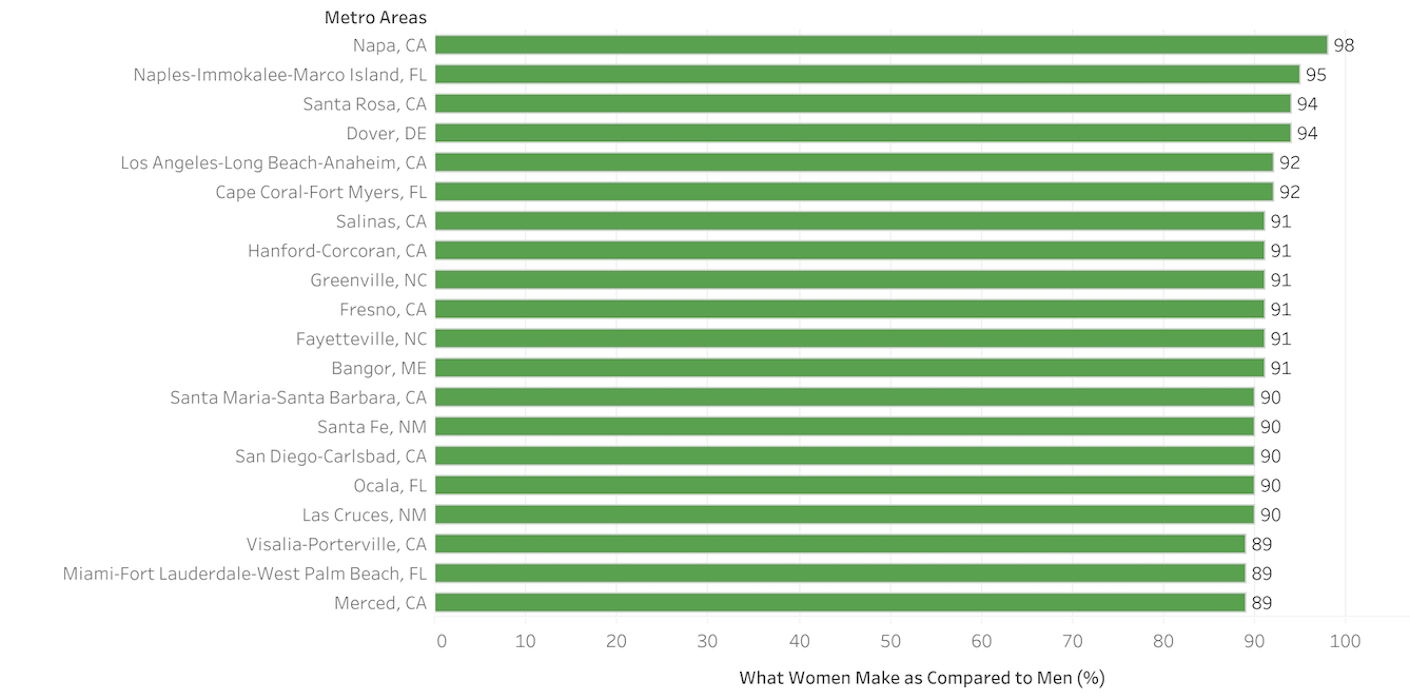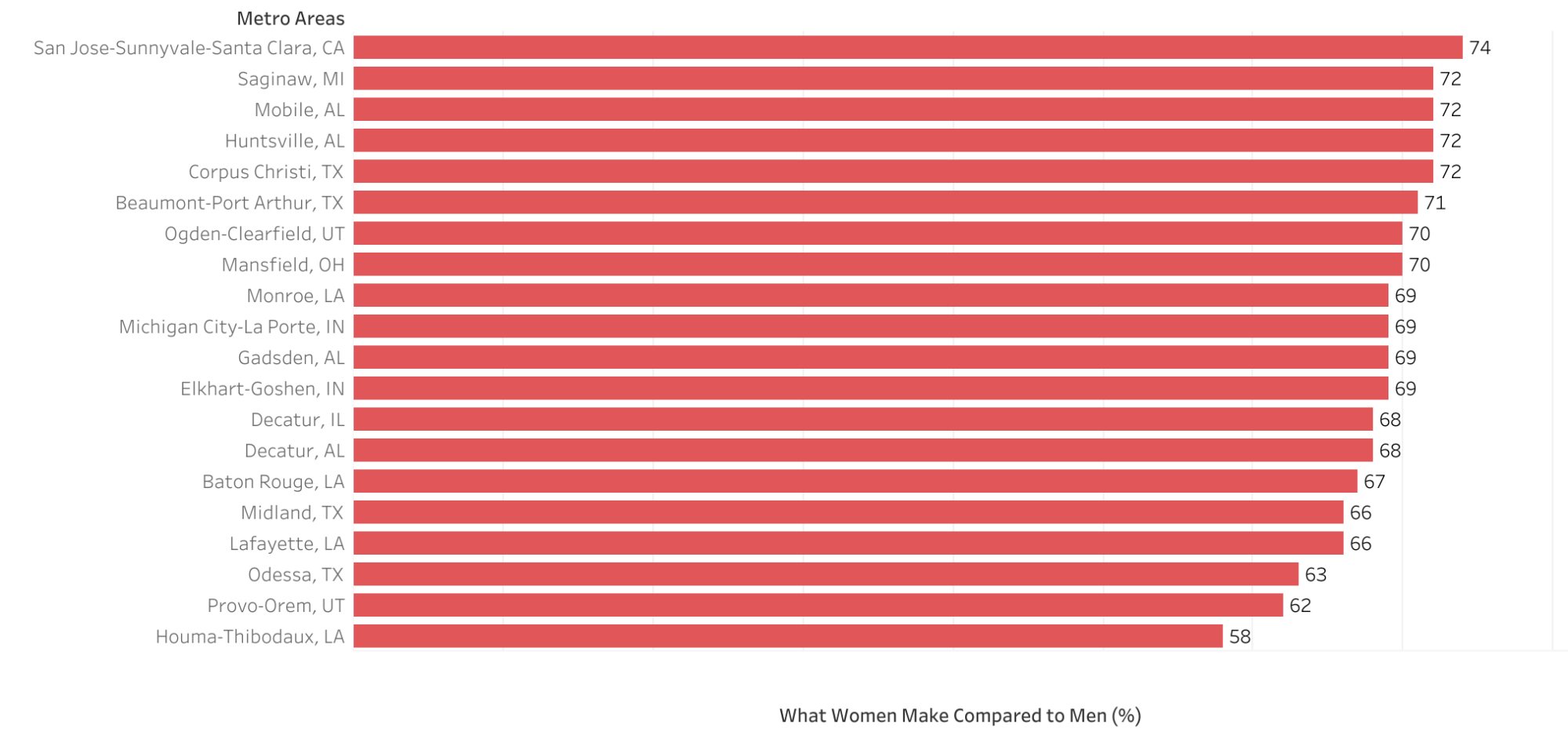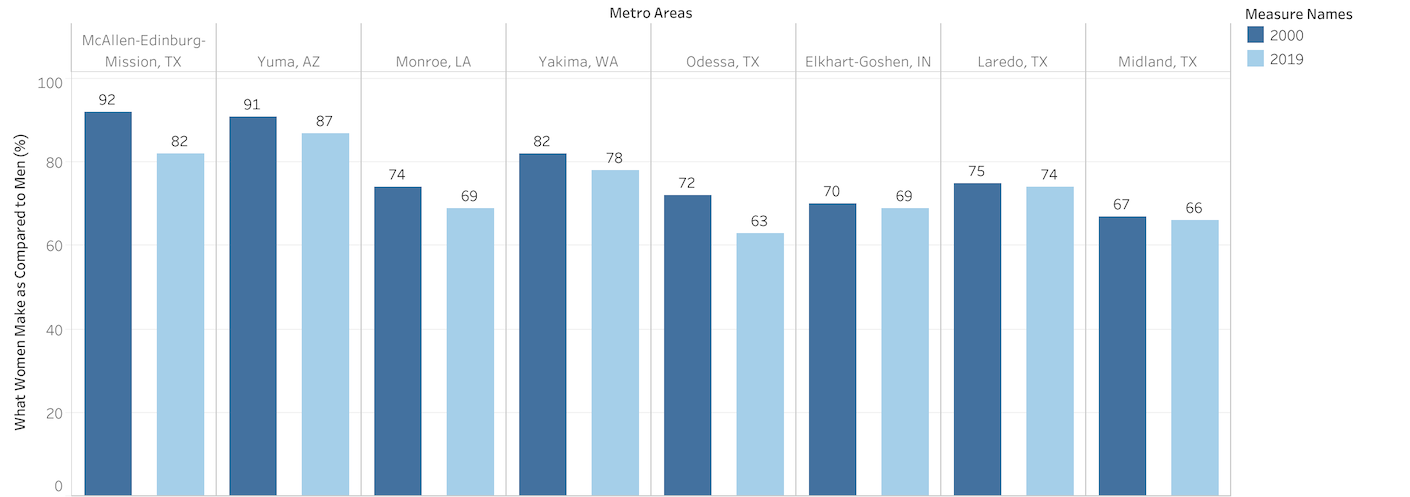Women are still getting the short end of the stick when it comes to pay. According to recent data from Pew Research, some women in the United States suffer the perils of larger wage gaps than others because of where they work or live.
When comparing wages in metropolitan areas across the country, Pew found on average women earn 82 cents on every dollar that men earn. Overall, the gender pay gap in metropolitan areas has narrowed for women over the age of 16 since 2000. However, in eight areas, the pay gap has actually increased.
The survey includes data from full-time, year-round workers who worked at least 35 hours per week, but excludes self-employed workers. The data compares earnings in 2000 to earnings in 2019, since data collection was severely disrupted in 2020 by Covid-19.
Where Women Make the Most Money Compared to Men in the U.S.
According to these findings, there aren’t any metro areas where women make a dollar for every dollar a man earns. The closest is Napa, California, where women earn 98 cents to every dollar a man earns. Next is Naples, Florida, where women make 95 cents. In Santa Rosa, California and Dover, Delaware, women make 94 cents, and in Los Angeles, California and Fort Myers, Florida, they earn 92 cents. This is followed by the six places where women make 91 percent of what men make — Salinas, Hanford-Corcoran, and Fresno in California, Greenville in North Carolina, and Bangor in Maine.

Where Women Make the Least Compared to Men in the U.S.
Pew finds that Houma-Thibodaux, Louisiana is the worst performing metro area with women making 58 cents to every dollar men make (Oh, dear God). Slightly better off are Provo-Orem, Utah at 62 cents for every dollar, and Odessa, Texas at 63 cents for every dollar. A few points higher are Lafayette, Louisiana and Midland, Texas at 66 cents for every dollar, followed by Baton Rouge, Louisiana at 67 cents. This is followed by Decatur, Illinois and Decatur, Alabama where women make 68 percent of what men make. Slightly better off at 69 percent are Michigan City-La Porte and Elkhart-Goshen in Indiana, Monroe in Louisiana, and Gadsden in Alabama.

Where the Pay Gap For Women Has Increased Since 2000
The largest increase in pay gap has taken place in McAllen-Edinburg-Mission, Texas, where women earned 92 percent of what mean earned in 2000, but only 82 percent in 2019. The data also tells us that four out of eight places where the pay gap has increased are in Texas. The other four are in Arizona, Louisiana, Indiana, and Washington.

So, do politics have anything to do with the pay gap?
Among the cities where women over age 16 earn the most relative to men, 10 out of 20 metro areas (50 percent) are in California (yup, the Golden State). The best performing place is Napa, California with women earning 98 percent of what men earn. Fourteen out of 20 top-performing metros are in blue states (based on the 2020 election results). Among the six remaining metro areas, Florida takes the lead with four spots on the top 20 list.
On the other end of the spectrum, 17 out of the 20 metro areas with the largest pay gaps for women are in red states (based on the 2020 election results). The worst performing metro region is Houma-Thibodaux, Louisiana where women earn 58 percent relative to their male counterparts.
While there may be some visible correlation between political preferences and gender pay gap, the overall wage gap highlights that women are being unfairly compensated across the nation.
Based on United States Census Bureau data that looked at hourly wages for full-time workers across the country, women earned 82 percent of what men earned in 2019. This suggests that the trend in metro areas is similar to that in the rest of the nation.
The American Association of University Women finds that collectively working women lose out on over $500 billion a year. Now, that’s a lot of money! Even public figures are subject to this wage gap; recently, NPR noted that male NBA players make 45 times as much as their female counterparts — in fact, WNBA star Brittney Griner’s manager said the gender pay gap led to her recent imprisonment in Russia.
How non-white women are affected by the wage gap
As one would predict, the picture gets bleaker as we break the data down across racial lines. Relative to white, non-Hispanic men, the following are women’s earnings:
Latinas: 55%
American Indian or Alaska Native: 60%
Native Hawaiian or Other Pacific Islander women: 63%
Black women: 63%
Asian women: 87%
As identities stack up, some women are being especially disadvantaged in the workplace.
But, some good news…
While progress is slow across the nation in general and women are still struggling to get equitable pay, there are 16 metro areas where young women (under 30) now earn more than men and six others where they earn as much.
There’s still a long way to go to achieve gender parity, but small victories make us believe that we can at least move the needle forward, albeit slowly. In fact, according to Pew, 45 percent of Americans believe that equal pay is an important pillar of gender equality.
Finally, if you’re thinking about how you can ensure that you get paid fairly and are looking for salary negotiation tips, check out Katie’s conversation with Ellevest CEO Sallie Krawcheck.













